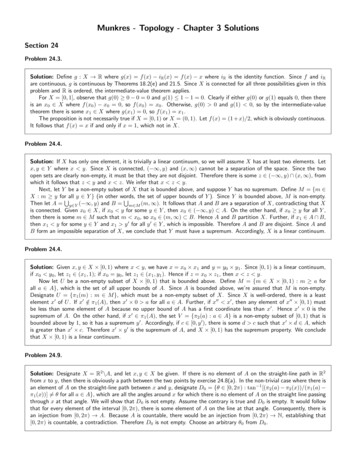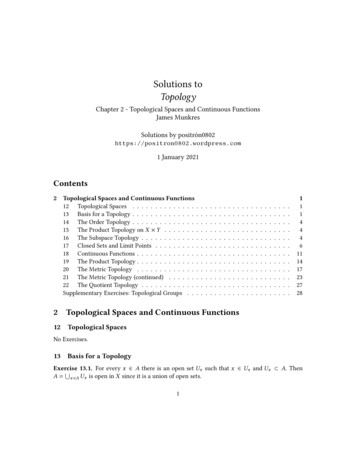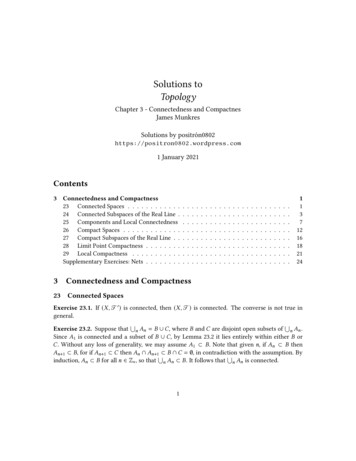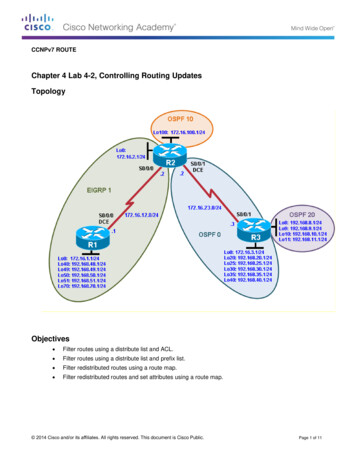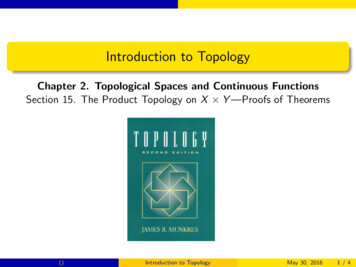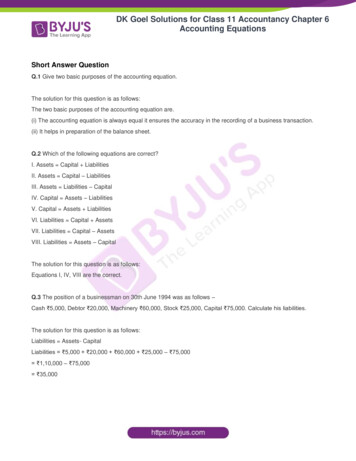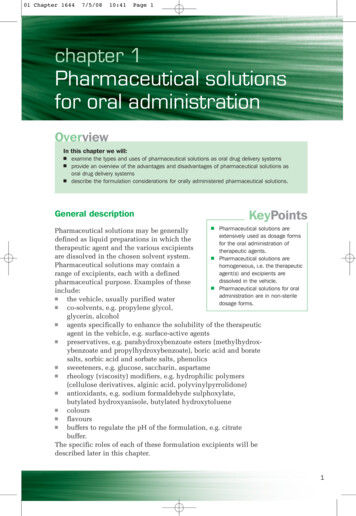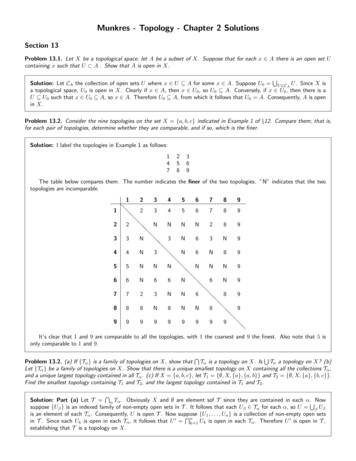
Transcription
Munkres - Topology - Chapter 2 SolutionsSection 13Problem 13.1. Let X be a topological space; let A be a subset of X. Suppose that for each x A there is an open set Ucontaining x such that U A . Show that A is open in X.SSolution: Let CA the collection of open sets U where x U A for some x A. Suppose U0 U CA U . Since X isa topological space, U0 is open in X. Clearly if x A, then x U0 , so U0 A. Conversely, if x U0 , then there is aU U0 such that x U0 A, so x A. Therefore U0 A, from which it follows that U0 A. Consequently, A is openin X.Problem 13.2. Consider the nine topologies on the set X {a, b, c} indicated in Example 1 of §12. Compare them; that is,for each pair of topologies, determine whether they are comparable, and if so, which is the finer.Solution: I label the topologies in Example 1 as follows:147258369The table below compares them. The number indicates the finer of the two topologies. ”N” indicates that the twotopologies are incomparable.123456789123456789@23456789@@2 @NNNN289@@3N @3N63N9@@4N3 @N6N89@@5NNN @NNN9@@6N66N @6N9@@723NN6 @89@@88N8NN8 @9@@99999999 @@@It’s clear that 1 and 9 are comparable to all the topologies, with 1 the coarsest and 9 the finest. Also note that 5 isonly comparable to 1 and 9.TSProblem 13.2. (a) If {Tα } is a family of topologies on X, show that Tα is a topology on X. Is Tα a topology on X? (b)Let {Tα } be a family of topologies on X. Show that there is a unique smallest topology on X containing all the collections Tα ,and a unique largest topology contained in all Tα . (c) If X {a, b, c}, let T1 { , X, {a}, {a, b}} and T2 { , X, {a}, {b, c}}.Find the smallest topology containing T1 and T2 , and the largest topology contained in T1 and T2 .TSolution: Part (a) Let T α Tα . Obviously X and are element sof T since they are contained in each α.S Nowsuppose {Uβ } is an indexed family of non-empty open sets in T . It follows that each Uβ Tα for each α, so U β Uβis an element of each Tα . Consequently, U is open T . Now supposeTn {U1 , . . . , Un } is a collection of non-empty open setsin T . Since each Uk is open in each Tα , it follows that U 0 k 1 Uk is open in each Tα . Therefore U 0 is open in T ,establishing that T is a topology on X.
SThe set α Tα is not necessarily a topology on X. Suppose X Z. Let T0 , T1 be topologies on X where Z 0 T0and Z 0 T1 but Z 0 Z 0 is not in either. Let T T0 T1 . We have Z 0 and Z 0 open in T , but Z 0 Z 0 Z\{0}is not open in T . It follows that T is not a topology on X.SPart (b) The smallest toplogy on X is Ts generated by the subbasis S α Tα . As we have seen, Ts is a topology, andit contains every Tα . Now suppose there is a topology T 0 that is strictly coarser than Ts (i.e., T 0 Ts ). Let U Ts \T 0 ,which must exist. If U is open in any Tα , then Tα cannot be contained in T 0 . It follows that every element in the subbasisS must be in T 0 . On the other hand, suppose U is not contained in the subbasis S, in which case it is not in any Tα . Itfollows that U must the union or finite intersection of a subcollection of elements in S. If the former, there is an indexedfamily {Sβ } S whose union is not in T 0 , which contradicts that T 0 is a topology. Alternatively, there is a subcollection{S1 , . . . , Sn } whose intersection is not in T 0 , also contradicting that T 0 is a topology. Because there are no other possibleelements of Ts that are not in T 0 , we conclude that Ts T 0 . As a result, T is the unique smallest topology on X thatcontains all Tα .TThe largest topology on X containing all Tα is Tl α Tα , which (by part(a)) is a topology. Clearly Tl Tα for allα. Suppose there is a T 00 that is strictly finer than Tl and is contained in all Tα . Let U Tl \T 00 . It follows that U is notan element of some Tα (otherwise, it would be the intersection of the topologies). As a result, we reach the contradictionthat T 00 is not contained in Tα . Consequently, Tl is the largest topology on X contained in all Tα .Part (c) The smallest topology containing T1 and T2 is { , X, {a}, {b}, {a, b}, {b, c}}. Notice that this is the topologygenerated by the subbasis equal to T1 T2 .The smallest topology contained in T1 and T2 is T1 T2 { , X, {a}}.Problem 13.5. Show that if A is a basis for a topology on X, then the topology generated by A equals the intersection of alltopologies on X that contain A. Prove the same if A is a subbasis.Solution: Suppose A is a basis for a topologyTA on X. Let {Tα } be an indexed collection of all topologies on X whereTA is contained in each Tα , and let TB α Tα (which is a topology by exercise 13.4(a)). Suppose that U0 is an open setin TA . We infer from Lemma 13.1 that U0 is the union of some subcollection of A. Since this subcollection is containedin each topology Tα , it follows that their union is in each, so U0 is open in TB . Therefore TA TB . Conversely, since TAis a topology on X containing A by definition, it follows that TB TA . Thus TA TB .The argument for a given subbasis S for a topology on X is very similar. Let TS be the Ttopology generated by thesubbasis. Let {Tγ } be an indexed collection of all topologies on X containing S, and let TC γ Tγ . If U is open in TS ,it is equal to either the union or finite intersection of some subcollection in S. Since S is contained in each topology Tγ ,we infer that U is contained in each and is therefore open in TC . Therefore TS TC . Conversely, since TS is a topologycontaining S, it follows that TC TS . We conclude that TS TC .Problem 13.6. Show that the topologies of Rl and RK are not comparable.Solution: It suffices to show that neither of the topologies is finer than the other. Let Tl and TK be the topologies of Rland RK , respectively. A given x R is contained in the basis element [x, b) of Tl . However, every basis element of TKis an open interval (in some cases, minus the set K). There is no open interval (a, b) that contains x and is contained in[x, b] because a must be less than x. By Lemma 13.3, TK is not finer than Tl .Conversely, 0 is contained in the basis element ( 1, 1)\K of TK . Any basis element (a, b) of Tl contains x where a 0and b 0, but this basis element cannot be contained in ( 1, 1)\K. Given b 0, let k N where k 1/b. It followsthat 0 1/k b, so 1/k (a, b) but 1/k / ( 1, 1)\K. Again by Lemma 13.3, Tl is not finer than Tl . Hence Tl and TKare not comparable.Problem 13.8. (a) Apply Lemma 13.2 to show that the countable collection B {(a, b) a b, a and b rational} is a basisthat generates the standard topology on R. (b) Show that the collection C {[a, b) a b, a and b rational} is a basis thatgenerates a topology different from the lower limit topology on R.Solution: Part (a) Let T be the topology generated by B and TR be the standard topology on R. Let U0 be an open setin T . It follows that U0 is the union of some subcollection {Bk } of B. Since B is a subset of the basis of TR , it followsthat U0 is open in TR . Conversely, given a set U1 open in TR , there is a subcollection {Bl0 } of TR ’s basis who union equalsU1 . Given x U1 , there is a Bl0 (a0 , b0 ) containing x. By the density of rational numbers, there are a, b Q wherea0 a x b b0 such that (a, b) B B and B is contained in Bl0 . It follows that U1 is open in T , from which weconclude that T and TR are equal.Page 2
Part (b) Let TC be the topology generated by C and Tl be the lower-limit topology on R. We will show that Tl is finerthan TC . Given x R, we see that x is contained in any basis element [a, b) of TC where a, b, Q and a x and x b(which must exist by the density of rational numbers). But [a, b) is also a basis element of Tl , so by Lemma 13.3 Tl is finerthan TC .Now let x be irrational. It follows that x is contained in the basis element [x, y) of Tl where y R and x y. However,there is no basis element of TC that contains x and is contained by [x, y). If [α, β) contains x where α, β are rational,then necessarily α x, so [α, β) is not a subset of [x, y). By Lemma 13.3, TC is not finer than Tl . Accordingly, the twotopologies are not equal.Section 16Problem 16.1. Show that if Y is a subspace of X, and A is a subset of Y , then the topology A inherits as a subspace of Y isthe same as the topology it inherits as a subspace of X.Solution: Let BX be a basis of the topology of X, let TYX be the subspace topology of Y inherited from X, and letTAX and TAY be the subspace topologies of A inherited from X and Y , respectively. By Lemma 16.1, a basis of TYX isYBYX {B0 Y : B0 BX } and a basis of TAY is BA {B1 A : B1 BYX } {(B0 Y ) A : B0 BX }. Since A isY {B0 A : B0 BX }. But this seta subset of Y , it follows (B0 Y ) A B0 (Y A) B0 A. Therefore BAXXis also a basis for the subspace TA inherited from X. Since the bases for TA and TAY are equal, it follows that the twotopologies are equal.Problem 16.2. If T and T 0 are topologies on X and T 0 is strictly finer than T , what can you say about the correspondingsubspace topologies on the subset Y of X?Solution: Let U0 be open in the subspace topology TY of T . There is a W0 T where U0 W0 Y . But since T 0 isfiner than T , it follows that W0 is open in T 0 , so W0 Y U0 is open in the subspace topology TY0 of T 0 . Therefore TY0is finer than TY .We cannot say that TY0 is necessarily strictly finer than TY . Suppose X N, and T 0 { , {2}, {3}, {2, 3}, N}, andT { , {2}, N}. Let Y0 {1, 2}. As a result, TY00 TY0 { , {2}}. On the other hand, if Y1 {1, 2, 3}, then TY1 TY0but TY01 { , {2}, {3}, {2, 3}}, so TY01 is strictly finer than TY1 .Problem 16.9. Show that the dictionary order topology on the set R R is the same as the product topology Rd R whereRd denotes R in the discrete topology. Compare this topology with the standard topology on R2 .Solution: We’ll designate the dictionary-order topology as Td and the product topology Up . From Example 14.1, thebasis of Td is the collection of intervals (a b, c d) where a c or where a c and b d. The text indicatesthat collection of intervals Bd {(a, b) (a, d) : b d} (i.e., where only the second condition is true) is also a basisof Td . We’ll show thatS here. A given set W that is open in Td is equal to the union of of a subcollection of basiselements. Let W α (a b, c d)α . For each (x, y) W , it follows that (x, y) is contained in some (a b, c d)α .If a c, this basis element is in Bd . Otherwise, a x c, and there is a basis element B (x, c) (x, d) Bd where(x, y) B (a b, c d)α . (If (x, y) is in multiple basis elements in the union, you can choose c and d to be smallenough to contain all of them.) By Lemma 13.2, Bd is a basis of Td .A basis for the discrete topology Rd is Bd {{x} : x R} (i.e., the collection of all singletons of R). Given V Rd ,for x V , it follows that x {x} V . Therefore Bd is a basis of Rd . The standard basis for R is, of course, the collectionof intervals (a, b) where a b.With the foregoing results and Theorem 15.1, a basis Bp for Up is the collection of sets {x} {a, b} where a, b, x Rand a b. But {x} {a, b} ((x, a), (x, b)) (x, a) (x, b), so Bp and Bp are identical. Since they generate the sametopology, Td and Up are equal.Next we will compare this topology with the standard topology of R2 . The basis of the standard topology is thecollection of sets (a, b) (c, d) where a b and c d. Any (x, y) R2 is contained in the basis element (a, b) (c, d)where a x b and c y d. At the same time, (x, y) {x} (c, d), which is a basis element of Up contained in(a, b) (c, d). By Lemma 13.3, Td and Up are finer than the standard topology. On the other hand, the standard topologyis not finer than Td and Up . For example, {1} R is open in Td and Up but is not open in the standard topology of R2 .As a result, Td and Up are strictly finer than the standard topology on R2 .Page 3
Section 17Problem 17.1. Let C be a collection of subsets of the set X. Suppose that and X are in C, and that finite unions andarbitrary intersections of elements of C are in C. Show that the collection T {X C CinC} is a topology on X.SSolution: Clearly X\X and x\ X are open in T . Suppose U α Uα for some indexed collection {Uα } of opensets in T . Since each Uα X\Cα for some Cα C, it follows that:[\U (X\Cα ) X\ Cα X\C 0 ,ααwhere C 0 is the intersection of {Cα }. By definition, C 0 C, so U is open in T .TNNow suppose V k 1 Vk for some finite collection {V1 , . . . , VN } of open sets in T . Since each Vk X\Dk for someDk C, it follows that:NN\[V (X\Vk ) X\Dk X\D0 ,k 10k 10where D is the finite union of {D1 , . . . , DN }. By definition, D C, so V is open in T . We conclude that T is a topologyon X.Problem 17.2. Show that if A is closed in Y and Y is closed in X, then A is closed in X.Solution: This question requires us to prove Theorem 17.3. By hypothesis, Y \A is open in Y , and there is some U openin X where U Y Y \A. Therefore X\U is closed in X. Consequently, since A Y :Y (X\U ) (Y X)\(Y U ) Y \(Y \A) A.By Theorem 17.1, A is closed in X.Problem 17.4. Show that if U is open in X and A is closed in X, then U A is open in X, and A U is closed in X.Solution: The set X\A is open in X. We have:U (X\A) (U X)\(U A) U \(U A) (U \U ) (U \A) U \A.By the definition of a topology, U \A is open in X.The set X\U is closed in X. We have:A (X\U ) (A X)\(A U ) A\(A U ) (A\A) (A\U ) A\U.By Theorem 17.1(3), A\U is closed in X.Problem 17.5. Let X be an ordered set in the order topology. Show that (a, b) [a, b]. Under what conditions what equalityhold?Solution: We can use Theorem 17.5(a), which implies that x (a, b) if and only if every neighborhood of x intersects(a, b). First we will show that (a, b) is a subset of [a, b] in all cases.
Munkres - Topology - Chapter 2 Solutions Section 13 Problem 13.1. Let Xbe a topological space; let Abe a subset of X. Suppose that for each x2Athere is an open set U containing xsuch that UˆA. Show that Ais open in X. Solution: Let C A the collection of open sets Uwhere x2U Afor some x2A. Suppose U 0 S U2C A U. Since Xis a topological space, U 0 is open in X. Clearly if x2A, then x2U 0, so .
